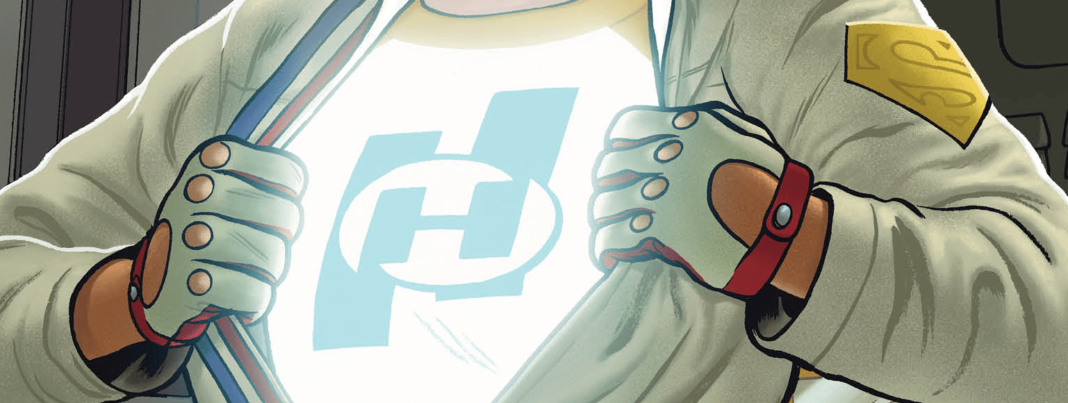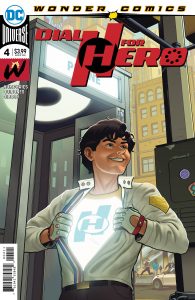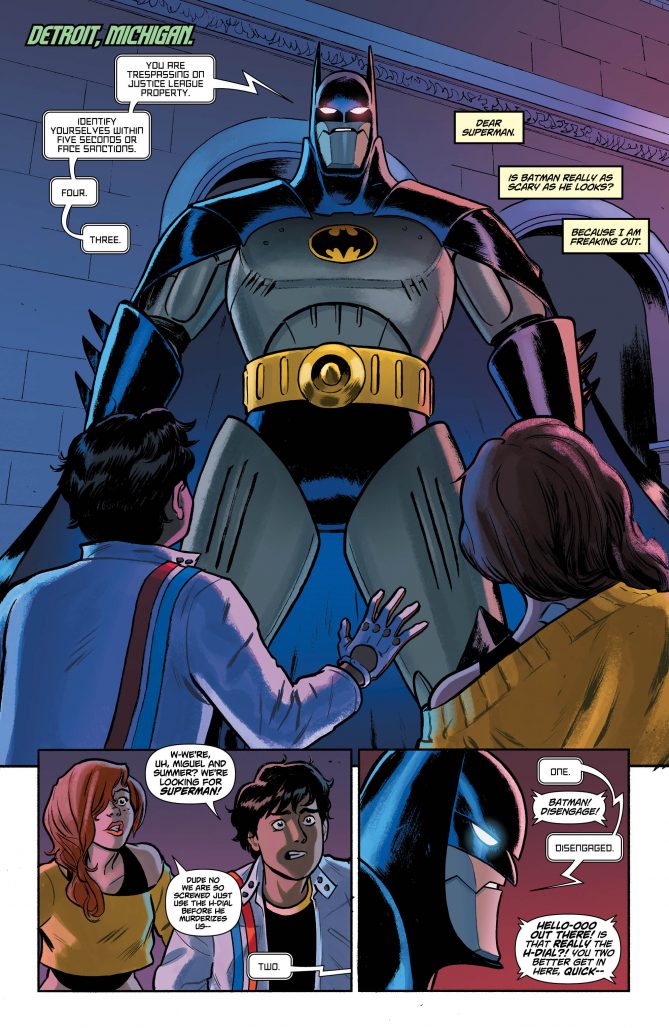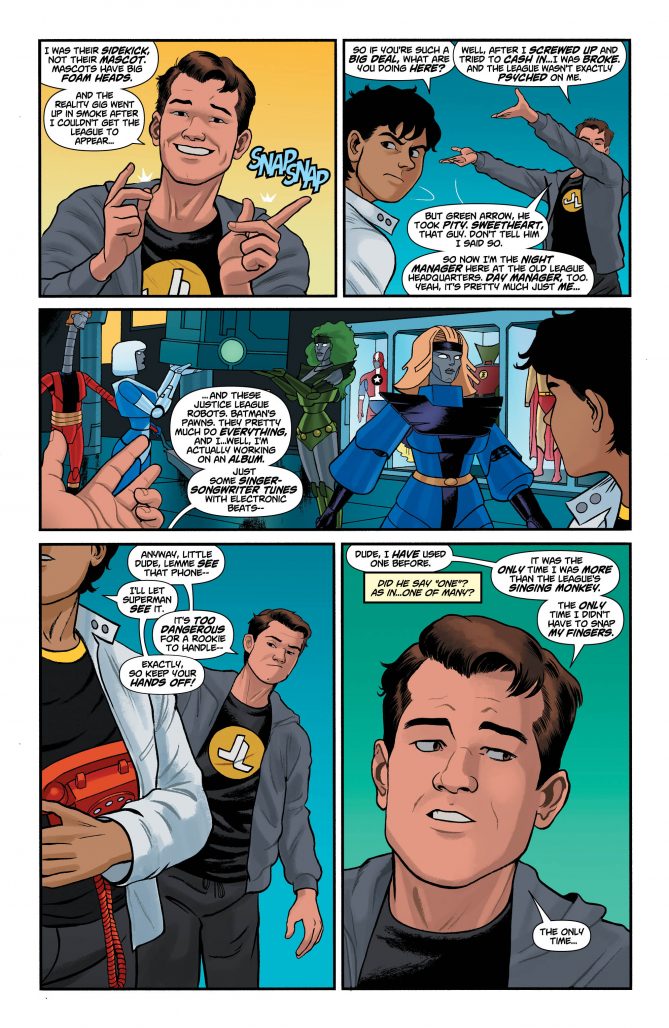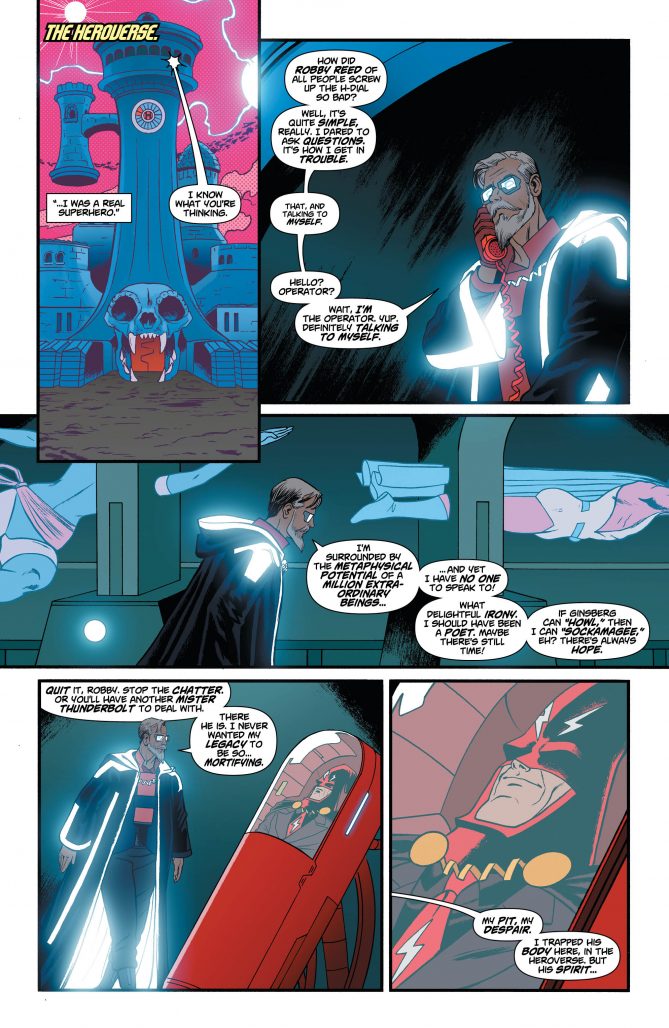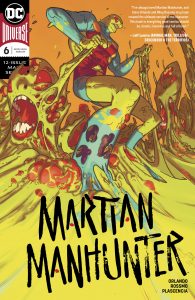DC Comics is trying something new. In the wake of their Rebirth initiative, the publisher has rapidly expanded its content to include diverse new imprints such as Young Animal, Wildstorm, Jinxworld, Wonder Comics, Black Label, Ink, and Zoom. As their lineup expands, it can be hard to figure out what to pick up each week. That’s what our team is here to help with, every Wednesday, with the DC Round-Up!
THIS WEEK: The artwork in Dial H For Hero #4 is really putting the wonder in Wonder Comics.
Note: the reviews below contain spoilers. If you want a quick, spoiler-free buy/pass recommendation on the comics in question, check out the bottom of the article for our final verdict.
 Dial H For Hero #4
Dial H For Hero #4
Writer: Sam Humphries
Artist: Joe Quinones
Additional Inks: Tom Fowler
Colorist: Jordan Gibson
Letterer: Dave Sharpe
This is, quite simply, the issue where Dial H For Hero really clicked for me. I mean, I’ve liked the book from the start, and I’ve long appreciated this concept in all its wish-fulfilling glory. Anyway can just pick up the H dial and get a random set of powers for a little while. Hell of a thing. And this new comic from the team of writer Sam Humphries and artist Joe Quinones just came at it with what I’ll describe as barely-restrained giddiness. They were, essentially, having a blast, and you could feel that from the start.
In this issue, however, the book for me took a major step forward with its character work and plotting. It sort of sneaks up on you, too. See, this issue starts out with a goofy dive in DC continuity, as our heroes explore the basically neglected headquarters of the Justice League Detroit, operated and tended to now by a set of Batman-built robots and Snapper Carr. Humprhies is an adept gag writer, and he strings a few good ones along here, doing the great levity work with the tone that has become a signature of this young Wonder Comics imprint.
Within those jokes, however, Humphries is also seeding our character’s deepest desires in a barely-noticeable way. Young Miguel badly wants to be the best caretaker he can for the H Dial, ultimately winning the respect and admiration of Superman, who way back in the first issue gave him the task. Indeed, much of this Wonder Comics line—Naomi, comes to mind—is about how the small folks in the DCU see Superman, how they interact with him from a distance, and how his very being gives shape or meaning to their mostly unrelated lives. This book does that exceedingly well. To the point that when Miguel ultimately gives into his ego and makes a big mistake that dramatically worsens the situation of our heroes, it’s the tear he sheds for what Superman will think that hits hardest on an emotional level.
That’s all very well done. Joe Quinones artwork (inked in parts by Tom Fowler and colored throughout by Jordan Gibson) compliments it perfectly too, whether he’s being asked to draw a noir character, the emotional beats that make us feel for Miguel so acutely, or the embarrassing newspaper comic strip character (who’s not wearing pants) that Miguel gets saddled with by the H Dial. This book simply cannot work without Quinones giving 100 on every rendition of the powers bestowed by the H Dial, without him conceiving of a distinct aesthetic that not only looks good but is capable of playing on tropes and other genres to clue readers into what the new powerset is all about.
Quinones work is also just outright hysterical at times (there’s a panel in this one where Miguel becomes a mix of Nancy, Hagar the Horrible, himself, and I think Cyclops that really got me). This series was recently extended to a 12-issue run. If we keep getting comics with this high level of creative alchemy between the artwork and the script, that is going to be a very good thing for us all.
Verdict: Buy
 Wonder Woman #73
Wonder Woman #73
Guest Writer: Steve Orlando
Guest Artist: Aaron Lopresti
Guest Inker: Matt Ryan
Colorist: Romulo Fajardo, Jr.
Letterer: Pat Brosseau
Wonder Woman is in a great place right now. The best place, perhaps, that the book has been in since writer Greg Rucka (as well as superstar artists Nicola Scott, Liam Sharp, and Bilquis Evely) departed the series following the first year of Rebirth.
Writer G. Willow Wilson took over the book late last year following years of work on Ms. Marvel, a run that established the Kamala Khan version of the titular hero as one of DC’s competitor’s brightest young characters. One of its most exciting new heroes this side of Miles Morales. When Wilson took over Wonder Woman, however, there was a somewhat noticeable adjustment period, as one might expect of a creator transitioning from a character she helped build from scratch to a veritable institution that was born before most of our parents and will most certainly outlive us all. Recently, Wilson has really found her a fresh perspective for this title, doing so by filtering Diana and her gods-adjacent world through the lens of a human protagonist. It’s led to some of the most interesting Wonder Woman comics in some time.
This week, though, Wilson and the stable of regular series artists are taking a breather. In their place, we get a one-shot inventory story from writer Steve Orlando and artist Aaron Lopresti, who is inked here by Matt Ryan and colored by Romulo Fajardo, Jr. Orlando has also done interesting work with the character in this post-Rucka stretch for the title. Orlando penned Wonder Woman #51 – #55 for a bevy of the most exciting artists in superhero comics today, including the team of Raul Allen and Patricia Martín (who I would love to see doing more DC work), and his Midnighter collaborator ACO. Issues #52 – #55 were an interesting enough story, rooted heavily in continuity. It was the one-short story, Wonder Woman #51, where the abbreviated run really shone. In fact, I’d place that story—with its interesting structure and heart-rending themes that cut deeply to the figurative heart of Diana’s boundless compassion—among the best Wonder Woman one-shots of all-time.
This is all a wordy way of noting I came into this one-shot issue with high expectations, and this book more than delivered. It’s almost a spiritual sequel to Wonder Woman #51, in that it’s a one-and-done that speaks to a fundamental aspect of the Wonder Woman character. Whereas the earlier story grew from her famed compassion, this one is about her relationship with her mother. In it, Diana and her mother, Queen Hippolyta, are in a dimension shaped by the latter’s darkest impulses. The Hippolyta here is an empress, not a queen, who rules by fear and force, rather than the support of her sisters. Oh, and rather than shape a daughter by clay, she destroyed her inkling to have a child, believing herself to be better off alone.
This is dark and relatable terrain, the suspicion that children (and, indeed, grown adults) harbor that perhaps their parents’ lives would have been better without them. As the story progresses, Diana is sidelined for most of it, with her mother battling the dark version of herself for control of the island, doing so simply so she can free Diana and leave. As they compete, the artists take us through a stunning collection of scenes that could only take place on Themyscira, my personal favorite being the Kanga Chariot race, which is exactly what it sounds like. The story ultimately comes to a climax wherein Diana saves the day, thereby proving herself to be additive to her mother’s life.
It’s a sweet story, one that avoids coming close to saccharine, because hey, this is superhero comics and a major status quo-threatening event is always right around a corner for our hero. It’s not as powerful as the tale in Wonder Woman #51, but it’s an expertly-told and immensely-satisfying read nonetheless. Perhaps most impressively, its ending brings us right back into the ongoing story that Wilson was already telling, all while teasing the return of more Amazons (!!) to these pages soon).
All told, it’s a wonderful thing to have a writer like Wilson leading the way on Wonder Woman, with a writer who understands the character as well as Orlando available for fill-ins that are such a joy to read.
Verdict: Buy
 Round-Up
Round-Up
- Speaking of Steve Orlando, his collaboration with artist Riley Rossmo on Martian Manhunter is really bearing some odd and excellent fruit. I thought Martian Manhunter #6 was the best issue yet, heartfelt yet still rooted deeply in the protagonist’s past mistakes, which is what this book is about. On a structural level, it’s a nice halfway point, given that it so directly connects the present day framing device with the trauma from Martian Manhunter’s tragic past.
- It’s not really a surprise at this point (given a mix of rumors and blatant scuttled plans of late), but Vertigo as an active imprint is now ending. That leaves the fate of one of this week’s best comics—High Level—up in the air, as it was part of last year’s Vertigo Rebirth. High Level has one more issue solicited for next month, with none currently announced for the future. If this is what it looks like, I hope the comic lands at an indie publisher (like former lablemates Safe Sex and Second Coming), because I like it a lot.
- I found Batman: Damned #3 to be a satisfying ending, although you can win me over pretty easily by putting ambiguity at the end of your superhero comic.
- Finally, Flash: Year One is outracing (sorry) my expectations. I love that this comic A. uses the Turtle as its antagonist, and B. leans into all the messy time travel weirdness that has long made The Flash the most comic book-y of the superhero comics. There’s been filler, to be sure (you’ll get that with 70-some issues), but Williamson continues to nail the really big moments within this run.
Miss any of our earlier reviews? Check out our full archive!


